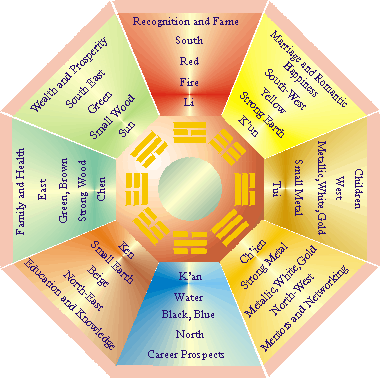Feng Shui Traditions

Feng Shui Traditions | |
 |
The PaKua that you see to the left, also referred to as the Bagua (you will notice that I will try to give all of the most common names for texts or symbols in this document, for many times there are more than one), is centered around the I-Ching, or the book of changes. Each symbol is associated with certain elements, colors, rooms, people, emotions, social positions, etc. All of these factors coordinate to bring us the ancient philosophy of Feng Shui. Some schools believe that the directional references (i.e. NW, SE) do not apply. Rather, use the Bagua as a pattern and turn it so that Ken, sometimes also called Gen, is in the position of the front door or entranceway, and the others will fall into place with the rest of your home. |
| What the tradition advises is to first assess your life situation. What areas do you feel you need improvement in? The next thing to do is assess your living space. What area of your home corresponds (according to the Bagua) with the troubled part(s) of your life? For example, perhaps you are having trouble with money. So you decide to consult the Bagua, and find that the SE direction governs wealth and prosperity. Maybe your bathroom is in the SE corner of your home, so you could, say, paint your wooden mirror frame a lovely shade of green, or place fresh green towels on a new wooden towel bar. Or, even more simply, think of feng shui as partially governed by your own psyche. If your money seems to be 'going down the toilet', try closing the lid! But whatever the case, never forget that you are ultimately in control of your own fortune! |
 Li Li |
 K'un K'un |
 Tui Tui |
 Ch'ien Ch'ien |
 K'an K'an |
 Ken Ken |
 Chen Chen |
 Sun Sun |
| home | Feng Shui for the New Millenium | I-Ching | Space clearing |